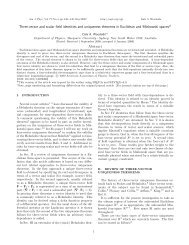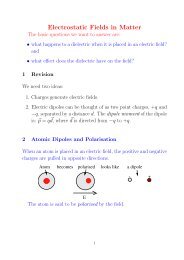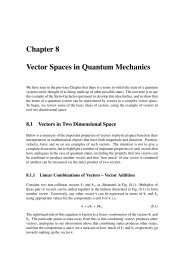AOS News - The Australian Optical Society - Macquarie University
AOS News - The Australian Optical Society - Macquarie University
AOS News - The Australian Optical Society - Macquarie University
- No tags were found...
You also want an ePaper? Increase the reach of your titles
YUMPU automatically turns print PDFs into web optimized ePapers that Google loves.
<strong>AOS</strong> <strong>News</strong> Volume 25 Number 1 2011Figure 4. EPR entanglement in the real world – not a quantum paradox but the foundation offuture technology. This apparatus creates optical beams which performs better than the best laserand demonstrates spatial entanglement, the correlation of the position and direction of the laserbeams better than the conventional Heisenberg uncertainty limit. Details are given in [7].what a truly practical system would looklike. Australia became a leading forcein developing one particular approach:Phosphor atoms imbedded in precisepositions in silicon were the medium ofchoice. This was later complemented bya major effort to utilize optics based onentangled photons [8].<strong>The</strong> era of quantum technologyIn 2002 the opportunity arose toincrease the speed of research and toform more effective collaborations acrossAustralia, to link the many groups that hadformed from the humble beginning in the1980s. Centres of Excellence are the logicalextension from the individually projects.<strong>The</strong>y allow to enhance the strength ofthe individual scientists, much like anorchestra enhances the sound of soloistsand to create bigger and more powerfulsound effects. It is the joint creativity ofthe group of individual scientists thatmake the difference.A formidable trio of Centres ofExcellence in Quantum Science wascreated. ACQAO, directed by HansBachor, combined both coherent opticsand coherent matter waves based onBEC to investigate the concepts andpracticalities of macroscopic entanglementof many particles, photons and atoms,both Bosons or Fermions. It linkedresearch at ANU, UQ and SUT. Fig. 5shows many of the members of the currentCentre. Similarly CQCT, the Centre forQuantum Computing technology, ledfirst by Robert Clark and now MichelleSimmons, combined the techniques forcreating quantum computer systemsin silicon at UNSW and Melbourne<strong>University</strong> with optics and theory at UQ.And CUDOS, the Centre for Ultrahighbandwidth Devices for <strong>Optical</strong> System, ledby Ben Eggleton which is focused on theclassical aspects of optical communicationsystems combining the strengths of Sydney<strong>University</strong>, ANU and SUT.For the last 8 years these three Centreshave been able to create a tremendousamount of progress and output, establishedthe field in the wider community andcreate the international recognition wenow enjoy. At the same time other teamswhere established. More Universitiesinvested into this field, in particular<strong>Macquarie</strong> <strong>University</strong>, Monash <strong>University</strong>,UWA, Sydney <strong>University</strong> and Adelaide<strong>University</strong> in Optics. A major force inFigure 5. Members ACQAO and of theadvisory board in 2010 at the ICAP2010conference in Cairns. This event, andparallel conferences before and after,created a major forum for discussionsand planning of future scientific work.the physical science in Australia has beencreated with at least 40 groups, somesupported and operating individually andothers as part of three active ARC COEs[2][8][9].Future opportunitiesWe now have developed thefundamentals of quantum optics. Wehave created a set of beautiful experimentsand a comprehensive theory that allowsus detailed modeling of the results.<strong>The</strong> progress in quantum optics hasbeen in two directions: quality andreliability, both allowing complexity.<strong>The</strong>se are two requirements for futurepractical applications. In order to makethe quantum effects as strong as possibleand at the same time robust we needmachines that have very high efficienciesand stay tuned for long times. We willhave to combine many quantum systems,or in information language q-bits, to buildmachines that can perform complex tasks,eventually outperforming their classicalcounterparts. Fig.6 illustrates the recenttrends of both photon and atom opticsin these directions.Starting from simple systems, suchas the laser or an ultracold atomicensemble of atoms, we have seen dramaticimprovements in the reliability andcomplexity. We can now build machines,which include multiple entangled statesof light on one hand and have fully15
















